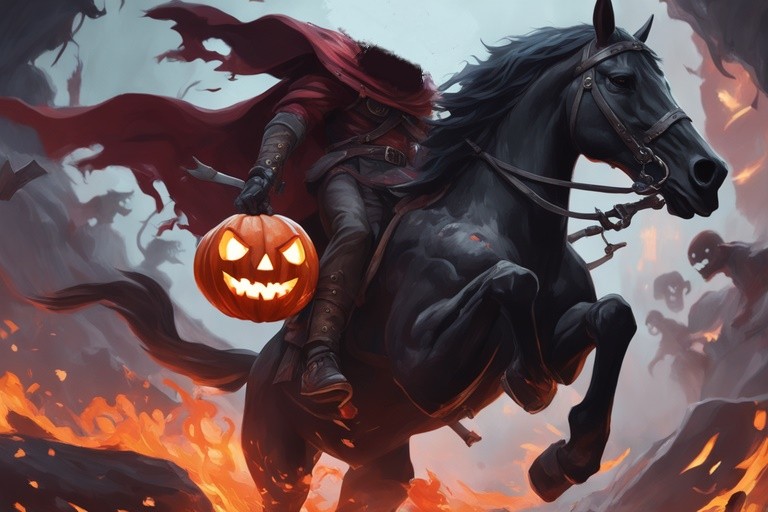The Legend of the Headless Horseman (Origin)
Although the popularity of this fictional character has turned him into a legend, transferring his story to the present day with countless stories, films, series and stories after the North American writer published an essay on short stories in 1820. Washington Irving recorded the Headless Horseman as a cult character in "The Legend of Sleepy Hollow."
Let's say that Washington Irving and his short story immortalized the headless horseman for posterity, but he did not invent the character, the headless horseman comes from much further back:
In Irish/Celtic mythology
The headless horseman is called Dullahan, his beginnings are many centuries before the appearance of Irving's short story, since it is believed that the Dullahan is nothing more than the earthly reincarnation of a powerful Celtic god called Crom Dubh, whom to honor In his cult, human sacrifices were made to him, approximately until the 6th century, when the introduction of Catholicism in Ireland and Scotland began to gain strength and the cult was forgotten, but not the headless horseman, in the Celtic version, the Headless Horseman , he used to be seen on dark nights on days of festivities or when banquets were held, always riding on the back of a horse as black as the night, he carried his severed head under his arm, which showed a macabre smile, his eyes black They looked in all directions and could see through the veil of night, in some versions, Dullahan's head lit up with a kind of fluorescent light that illuminated his path. When the Dullahan appeared it was an omen of death, it was impossible to stop him or prevent his passage, since when he rode all the doors, bolts and padlocks would open, if the Dullahan dismounted from his horse, it was indicative that someone nearby would die, when the Dullahan Dullahan pronounced a name, that person died immediately!!! As a weapon, the Dullahan carried a devilish whip that he used to blind the unsuspecting people he encountered along the way since he did not like to be seen when he rode looking for a victim. It is said that his whip was actually the spine of the corpse of one of the victims. his victims. Irving undoubtedly took certain elements from this character to create his own.
In German/Germanic mythology
The character of the headless horseman in Germanic culture dates back to approximately the 15th century, perhaps a little earlier, they were scary tales passed down from generation to generation vocally among German peasants and locals who lived away from the big cities in the countryside, although its story transcended and became popular later, gaining resonance and recognition thanks to the great work of compiling stories of myths, legends and popular tales from the German countryside made by the famous Brothers Grimm, who learned about these stories and published them in their first compilation for the year of 1812, they tell two stories about the headless horseman:
The first story occurs in the countryside near the city Dresden, in Saxony, a young peasant woman leaves her house early in the morning to go to a nearby forest called "Lost Waters" to collect strawberries and acorns, while she is collecting the fruits she is surprised. by the sharp sound of a hunting horn, which she ignores, the sound is getting closer and closer, when she finally hears it behind her, the young woman turns around and sees a ghost, a headless man wearing a gray coat and He rides a pale horse of the same color that ends up taking him with him forever.
The second also occurs in a rural environment now near the city of Brunswick, in Lower Saxony, in this story the headless horseman is known as "the wild hunter", he went out to ride at night on a black horse blowing his hunting horn, as a form of warning so that the surrounding villagers would not go on a trip or hunt the next day, the headless horseman in this version is "good" by using his supernatural powers to warn the villagers that They did not leave their homes to avoid an accident that could end in death.
Those were the two stories that the Brothers Grimm first collected in their compilation about the Headless Horseman, but there are other German versions, where the headless horseman is given characteristics of a vigilante or avenger from the afterlife, he went out at night riding on his black steed to "hunt" those responsible for capital crimes, so when a suspect in a murder appeared violently dead or disappeared completely, it was presumed that he was guilty and that the headless horseman had come for his soul.
Be that as it may, thanks to Washington Irving the story, the legend of the Headless Horseman became popular and became part of American culture and from there transcended borders and almost all of us know his story, in a small town in the state of New York called Sleepy Hollow events occurred, folklore has determined that a powerful Hessian (German) mercenary, a military body hired by the British Empire to try to prevent the independence of the United States, the headless horseman corresponds to one of them, killed in the battle of White Plains, upon receiving an accurate shot from a cannon that blew off his head, killing him instantly. After the battle, his body was collected and buried by his companions in the cemetery of the Sleepy Hollow church and from there the legend tells. that during the night of the Day of the Dead, he would rise from his grave and go out furious like a demon-possessed ghost to look for his lost head, and woe betide anyone who crossed him on the way.








Katrina Janus
Удалить комментарий
Вы уверены, что хотите удалить этот комментарий?
Noel Estrada
Удалить комментарий
Вы уверены, что хотите удалить этот комментарий?
natali gutierrez
Удалить комментарий
Вы уверены, что хотите удалить этот комментарий?